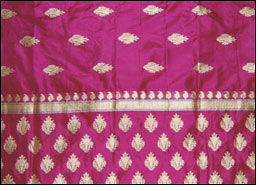Interviews
Varanasi handloom cluster cries for help
09 May '11
5 min read

In both price segments, saree has been facing problems and these problems do not appear temporary; notwithstanding occasional spurts in demand. These dress material, furnishing fabric, accessories-are selling on the strength of their own aesthetic/economic strength; without drawing strength from Banaras brand equity. The customers, unlike in case of sarees, do not actively seek Banaras weave in respect of these products. In fact, for dress material and furnishing fabric, the sector has not attempted product development; it merely sells fabric.
Tie and dye, Chikan and such other styles sell as ready-to-stitch salwar-kamiz kits; highlighting neck design, sleeve design, and so on. Banaras dress material is not sold this way. It sells as running fabric. Kutch sells cushion covers; Banaras sells only furnishing fabric. The non-saree product line is rather small in relation to total Banaras output, thus, is not showing any signs of noticeable growth.
The estimated of share of export in handloom output at Banaras varies from 2% to 3%, which is meagre. Besides sarees, other products which are exported are furnishing fabric, accessories and Buddhist brocade.
The exports, in most cases, entail large volumes (for a given trader). However, the industry does not have networking systems. The orders are time-bound. The exporter, many times, converts it into a power loom order. The products in the overseas market are largely positioned in purpose terms - saree, table runner, curtain, stole and its handloom identity remains either undeclared or low key.
There are few countries, eg, Australia and New Zealand which offer incentives for handmade products and so importers ask for an appropriate certification from the export council; hopefully bringing the fact of handmade product into focus. However, most of the world does not require such evidence at all.
The export products move largely on the strength of intrinsic aesthetics and workmanship; bereft of Banaras brand-equity. The foreign buyers remain fairly removed from Banaras in terms of reaching down directly to local traders and societies, leave alone weavers or asking explicitly for Banaras weave and design.
Under the quota system, handloom was not within the purview of quota. Now that quotas are phased out, the advantage is wiped out. The industry has not been able to also explore the neighbouring country saree/lahenga markets.
Click here to learn about Indian Handloom Clusters.
Tie and dye, Chikan and such other styles sell as ready-to-stitch salwar-kamiz kits; highlighting neck design, sleeve design, and so on. Banaras dress material is not sold this way. It sells as running fabric. Kutch sells cushion covers; Banaras sells only furnishing fabric. The non-saree product line is rather small in relation to total Banaras output, thus, is not showing any signs of noticeable growth.
The estimated of share of export in handloom output at Banaras varies from 2% to 3%, which is meagre. Besides sarees, other products which are exported are furnishing fabric, accessories and Buddhist brocade.
The exports, in most cases, entail large volumes (for a given trader). However, the industry does not have networking systems. The orders are time-bound. The exporter, many times, converts it into a power loom order. The products in the overseas market are largely positioned in purpose terms - saree, table runner, curtain, stole and its handloom identity remains either undeclared or low key.
There are few countries, eg, Australia and New Zealand which offer incentives for handmade products and so importers ask for an appropriate certification from the export council; hopefully bringing the fact of handmade product into focus. However, most of the world does not require such evidence at all.
The export products move largely on the strength of intrinsic aesthetics and workmanship; bereft of Banaras brand-equity. The foreign buyers remain fairly removed from Banaras in terms of reaching down directly to local traders and societies, leave alone weavers or asking explicitly for Banaras weave and design.
Under the quota system, handloom was not within the purview of quota. Now that quotas are phased out, the advantage is wiped out. The industry has not been able to also explore the neighbouring country saree/lahenga markets.
Click here to learn about Indian Handloom Clusters.
Fibre2fashion News Desk - India
Popular News
Leave your Comments
Editor’s Pick
Folker Stachetzki
Brother Internationale Industriemaschinen GmbH
Salvatore Piccione
Label - Salvatore Piccione
































-Ltd..jpg?tr=w-120,h-60,c-at_max,cm-pad_resize,bg-ffffff)





.jpg?tr=w-120,h-60,c-at_max,cm-pad_resize,bg-ffffff)
.jpg?tr=w-120,h-60,c-at_max,cm-pad_resize,bg-ffffff)






